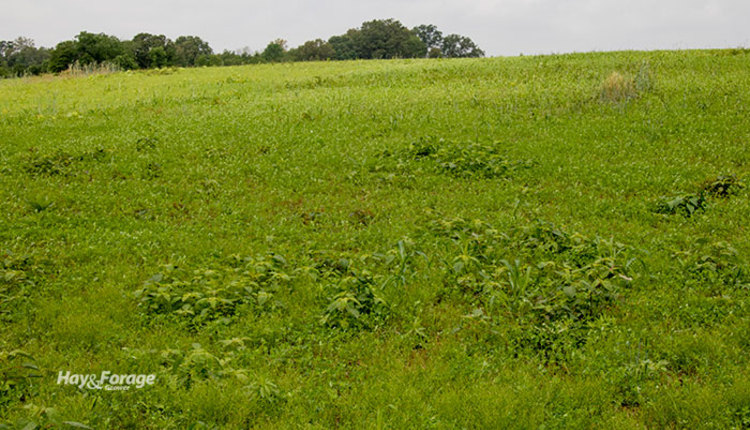Baby calves, new seedings, and a bad day |
| By Mike Rankin, Managing Editor |
|
|
 One of the rituals here at the W.D. Hoard & Sons Company is that the editors of each magazine proof copy from all the other magazines. This being the case, I read a lot of articles on the care of newborn dairy calves that will be published in Hoard’s Dairyman, our sister publication. As most dairy and beef producers are aware, an intentional calf care program during those first days of life and up until weaning has a lot to do with the success of the overall operation. The laundry list of best management practices is seemingly endless — but necessary. For the most part, raising healthy calves is a controllable process. The agronomic equivalent of a young calf is a new forage seeding. Here, too, there is a list of practices that will help ensure success. At the top of that list is high-quality seed and seeding depth. In my 27 years as an extension agronomist, I never got summoned to a farm to look at a good new seeding. Along those same lines, I doubt if the electric co-op gets many calls informing them that the barn lights are working. I did, however, have plenty of dates with failed or failing forage seedings. Evaluating new seedings, especially this time of year, is not always easy. Yes, there were those fields where I felt like the Pope issuing last rites in front of the forlorn field owner. More common is the situation where it was just too close or too early to make a call. Perhaps nothing in the forage production cycle is more aggravating, disheartening, disappointing, or sometimes frightening than a new forage seeding that just never develops. At worst, it means an entire establishment year lost, not to mention the time and investment in inputs such as seed, fertilizer, and herbicide. The point when a forage seeding is deemed worthless is always going to make for a bad day. At this point in the growing season, little can be done to revive a failed seeding. At the same time, be sure it’s failed. I have often seen stands that looked horrible in June suddenly come to life in September or the following spring. Dry weather has been widespread this year, and this might be the cause of a slow-developing new seeding. Where seedings do fail, it’s always a good idea to try and find the cause, similar to a postmortem evaluation on a dead animal. From experience, and in order of their likelihood, here are my top 5 reasons why new seedings fail. 1. Environmental conditions: Although the most common reason, it’s also the one we can’t control. Both cold and wet or hot and dry make for unfavorable establishment conditions. The former slows growth and can be beneficial for seedling diseases to take hold. A “death wish” on forage seedings is when just enough moisture is available for germination, and then the spigot turns off, leaving plants to wither. This is often more common with summer seedings but can occur in the spring. Any weather conditions that result in soil crusting before emergence are also detrimental to stand establishment. 2. Planting depth: This is the number one “controllable” reason for seeding failures, generally because seeds were placed too deep. Small forage seeds simply don’t have the stored resources to emerge from deeper placement. Always check seed placement early in the process of seeding a new field. 3. Seedling diseases: Most newer seed genetics have good to excellent resistance for plant diseases, but favorable environments for disease development can still humble genetics. This is especially true in the seedling stage when plants are more vulnerable. The myriad of plant disease organisms that can strike alfalfa seedlings include Pythium, Rhizoctonia, Phytophthora, and Aphanomyces. When plants are in the seedling stage, it’s often difficult to confirm the exact disease causal organism without lab analysis. A good seed-applied fungicide product, coupled with seed genetics, is the best defense against seedling diseases. 4. Herbicide carryover: Forage seedlings are extremely sensitive to certain herbicides that might have been used on last year’s crop. Further, soil type and environmental conditions over the previous summer and winter may exacerbate the problem. 5. Bad seed: Most new, purchased seed is of high quality; however, the same can’t be said for holdover or bin-run seed. Poor-quality seed is rarely the reason for a failed stand, but it can happen. I once was investigating a poor winter rye stand and, after eliminating other potential causal factors, got some of the bin-run seed to do a germination test at the state seed laboratory. It came back at 4%. Other possibilities: Depending on the forage species, new seedings can be vulnerable to weed or insect pressure. Here’s a situation where the initial stand may be good, but a lack of attention practices sends the seeding into a tailspin. The same can also occur where insufficient soil fertility or pH eventually restricts plant development. Finally, add to the list autotoxicity in the case where alfalfa is seeded too soon following a previous alfalfa stand. Going forward From now until late summer, continue to monitor marginal stands. Hopefully, your bad day won’t come, and last rites will never need to be issued. Most experts feel that at least 15 alfalfa plants per square foot are needed to keep a new seeding. Below that level, replanting in August or early September remains an option because autotoxicity is generally not a problem following a spring seeding of the same year. Often, it may be a situation where only portions of the field need replanted. This can be done with minimum surface tillage to these areas and reseeding; using a functional no-till drill is also an option. |
